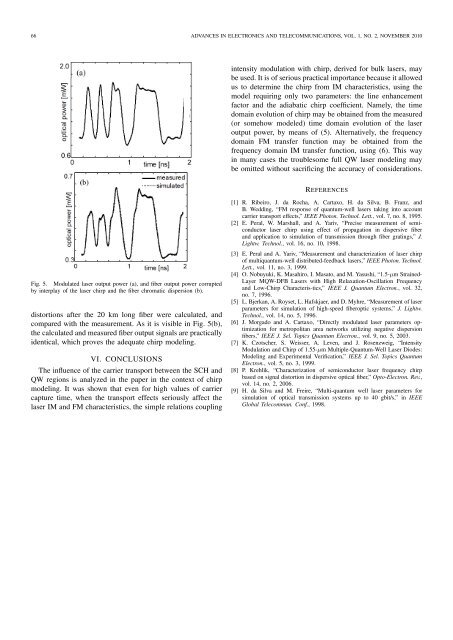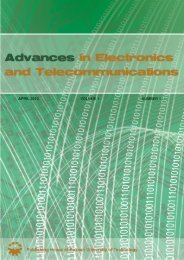november 2010 volume 1 number 2 - Advances in Electronics and ...
november 2010 volume 1 number 2 - Advances in Electronics and ...
november 2010 volume 1 number 2 - Advances in Electronics and ...
Create successful ePaper yourself
Turn your PDF publications into a flip-book with our unique Google optimized e-Paper software.
66 ADVANCES IN ELECTRONICS AND TELECOMMUNICATIONS, VOL. 1, NO. 2, NOVEMBER <strong>2010</strong><br />
Fig. 5. Modulated laser output power (a), <strong>and</strong> fiber output power corrupted<br />
by <strong>in</strong>terplay of the laser chirp <strong>and</strong> the fiber chromatic dispersion (b).<br />
distortions after the 20 km long fiber were calculated, <strong>and</strong><br />
compared with the measurement. As it is visible <strong>in</strong> Fig. 5(b),<br />
the calculated<strong>and</strong>measuredfiberoutputsignalsare practically<br />
identical, which proves the adequate chirp model<strong>in</strong>g.<br />
VI. CONCLUSIONS<br />
The <strong>in</strong>fluence of the carrier transport between the SCH <strong>and</strong><br />
QW regions is analyzed <strong>in</strong> the paper <strong>in</strong> the context of chirp<br />
model<strong>in</strong>g. It was shown that even for high values of carrier<br />
capture time, when the transport effects seriously affect the<br />
laser IM <strong>and</strong> FM characteristics, the simple relations coupl<strong>in</strong>g<br />
<strong>in</strong>tensity modulation with chirp, derived for bulk lasers, may<br />
beused.Itisofseriouspracticalimportancebecauseitallowed<br />
us to determ<strong>in</strong>e the chirp from IM characteristics, us<strong>in</strong>g the<br />
model requir<strong>in</strong>g only two parameters: the l<strong>in</strong>e enhancement<br />
factor <strong>and</strong> the adiabatic chirp coefficient. Namely, the time<br />
doma<strong>in</strong> evolution of chirp may be obta<strong>in</strong>ed from the measured<br />
(or somehow modeled) time doma<strong>in</strong> evolution of the laser<br />
output power, by means of (5). Alternatively, the frequency<br />
doma<strong>in</strong> FM transfer function may be obta<strong>in</strong>ed from the<br />
frequency doma<strong>in</strong> IM transfer function, us<strong>in</strong>g (6). This way<br />
<strong>in</strong> many cases the troublesome full QW laser model<strong>in</strong>g may<br />
be omitted without sacrific<strong>in</strong>g the accuracy of considerations.<br />
REFERENCES<br />
[1] R. Ribeiro, J. da Rocha, A. Cartaxo, H. da Silva, B. Franz, <strong>and</strong><br />
B. Wedd<strong>in</strong>g, “FM response of quantum-well lasers tak<strong>in</strong>g <strong>in</strong>to account<br />
carrier transport effects,” IEEE Photon. Technol. Lett., vol. 7, no. 8, 1995.<br />
[2] E. Peral, W. Marshall, <strong>and</strong> A. Yariv, “Precise measurement of semiconductor<br />
laser chirp us<strong>in</strong>g effect of propagation <strong>in</strong> dispersive fiber<br />
<strong>and</strong> application to simulation of transmission through fiber grat<strong>in</strong>gs,” J.<br />
Lightw. Technol., vol. 16, no. 10, 1998.<br />
[3] E. Peral <strong>and</strong> A. Yariv, “Measurement <strong>and</strong> characterization of laser chirp<br />
ofmultiquantum-well distributed-feedback lasers,” IEEEPhoton. Technol.<br />
Lett., vol. 11, no. 3, 1999.<br />
[4] O. Nobuyuki, K. Masahiro, I. Masato, <strong>and</strong> M. Yasushi, “1.5-µm Stra<strong>in</strong>ed-<br />
Layer MQW-DFB Lasers with High Relaxation-Oscillation Frequency<br />
<strong>and</strong> Low-Chirp Characteris-tics,” IEEE J. Quantum Electron., vol. 32,<br />
no. 7, 1996.<br />
[5] L.Bjerkan, A.Royset, L.Hafskjaer, <strong>and</strong>D.Myhre,“Measurement oflaser<br />
parameters for simulation of high-speed fiberoptic systems,” J. Lightw.<br />
Technol., vol. 14, no. 5, 1996.<br />
[6] J. Morgado <strong>and</strong> A. Cartaxo, “Directly modulated laser parameters optimization<br />
for metropolitan area networks utiliz<strong>in</strong>g negative dispersion<br />
fibers,” IEEE J. Sel. Topics Quantum Electron., vol. 9, no. 5, 2003.<br />
[7] K. Czotscher, S. Weisser, A. Leven, <strong>and</strong> J. Rosenzweig, “Intensity<br />
Modulation <strong>and</strong> Chirp of 1.55-µm Multiple-Quantum-Well Laser Diodes:<br />
Model<strong>in</strong>g <strong>and</strong> Experimental Verification,” IEEE J. Sel. Topics Quantum<br />
Electron., vol. 5, no. 3, 1999.<br />
[8] P. Krehlik, “Characterization of semiconductor laser frequency chirp<br />
based on signal distortion <strong>in</strong> dispersive optical fiber,” Opto-Electron. Rev.,<br />
vol. 14, no. 2, 2006.<br />
[9] H. da Silva <strong>and</strong> M. Freire, “Multi-quantum well laser parameters for<br />
simulation of optical transmission systems up to 40 gbit/s,” <strong>in</strong> IEEE<br />
Global Telecommun. Conf., 1998.







